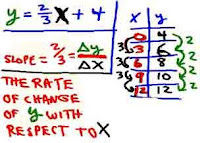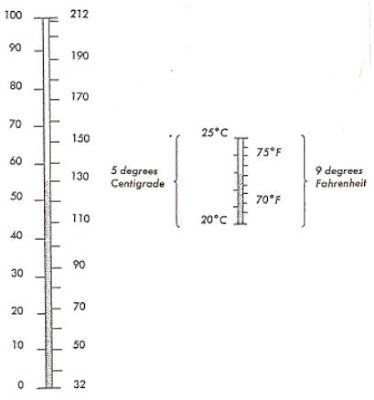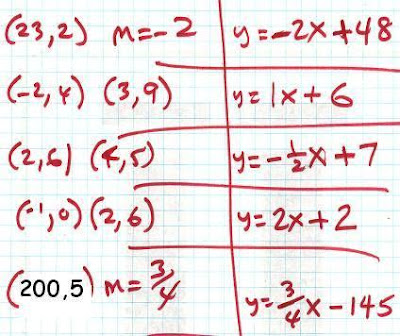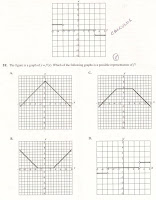LINK: Back to Contents
Instead of memorizing the formulas for Centigrade to Fehrenheit ----
Sunday, December 20, 2009
Monday, December 14, 2009
CALCULUS - graphing f' and f"
LINK: Back to Contents
Comparing f to f' to f"
******************
Example:
If y = Parabola
then y ' = Straight Line
If y = Parabola
then y ' = Straight Line
******************
f = position at time T
f = position at time T
f ' = Velocity
f " = Acceleration
******************
If you are given the Velocity
and asked to find the Distance Traveled
from Time t1 to t2, then INTEGRATE
the Velocity from t1 to t2.
AREA UNDER the VELOCITY!
Tuesday, December 8, 2009
Saturday, December 5, 2009
SLOPE (of a LINE)
FINDING the EQUATION of a LINE
What is this SLOPE THING?
Suppose we want to buy some T-shirts.
same amount. There is a charge
(an initial fee)
for setting up the logo for the order.
and 100 shirts would cost $633.
What is the COST for each shirt?
Dollars per Shirt!
(The SLOPE OF A LINE)
$540 divided by 90 shirts gives
a RATE (Cost per Shirt) of $6.00 per shirt.
Why then do 10 shirts at $6 each cost $93?
Because there is a set-up fee of $33.
The Cost formula that Mr. Smith uses is:
Total Cost = ( $6 ) times # of shirts PLUS $33
We could represent this with the equation:
y = 6 x + 33
(Note: y depends on x for its value!)
$$$$$$$$$$$$$$$$$$$$$$$$$$$$$$$
Take a look at the set of ordered pairs:
{ (3,11) (4,13) (5,15) (6,17)}
We notice that when X changes one unit
(11 to 13). As X changes 2 units (3 to 5),
Y changes 4 units (11 to 15).
NOTE:
We are not saying that the values for y
are twice as big as the values for x.
We are talking about changes in y and x.
We call this the RATE OF CHANGE OF Y
WITH RESPECT TO X. Graphing these points
onto the xy-plane and connecting the points
with a line we have what is called a line
with SLOPE of 2. The EQUATION that these
points SATISFY is y = 2x + 5. Notice the
SLOPE of 2 is situated next to x.
Picking a point on the graph and moving
3 units to the RIGHT (RUN)
and then moving
6 units UP (RISE) we will land
us back onto the line.
The RISE is 6 and the RUN is 3.
the FRACTION (RATIO)
RISE/RUN EQUALS 2.
One definition for the slope of a LINE
m = RISE/RUN.
How about the graph of the equation
y = (3/4)x - 1
Some of the ordered pairs that satisfy
this equation are {(4,2) (8,5) (12,8) ...}
When x changes 4 units, y changes 3 units.
The RATIO of 3 to 4 represents the
change in y with respect to the change in x.
THE CHANGE IN Y over the CHANGE in x is 3/4.
The slope of the graph of this equation is 3/4.
The SLOPE of the graph of the solutions to:
(i) a LINEAR FUNCTION f(x) = mx + b
(ii) an equation in the form Ax + By = C
(iii) or in the form y = mx + b
..........SLOPE is the rate that y changes
with respect to a change in x
..........In other words,
m = (y2-y1) / (x2-x1)
or m = change of y divided by the change in x
-----the values for x change by (x2-x1)
and the corresponding y's change by (y2-y1)



LINK: Back to Contents
Thursday, December 3, 2009
Subscribe to:
Posts (Atom)



















